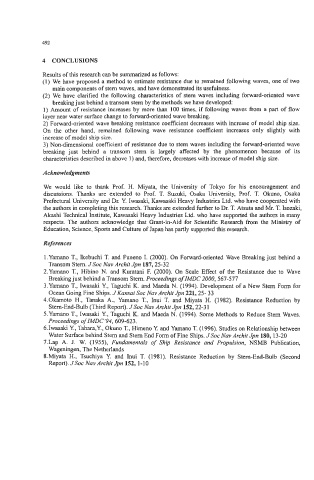Page 517 - Practical Design Ships and Floating Structures
P. 517
492
4 CONCLUSIONS
Results of this research can be summarized as follows:
(1) We have proposed a method to estimate resistance due to remained following waves, one of two
main components of stem waves, and have demonstrated its usefulness.
(2) We have clarified the following characteristics of stem waves including forward-oriented wave
breaking just behind a transom stem by the methods we have developed:
1) Amount of resistance increases by more than 100 times, if following waves from a part of flow
layer near water surface change to forward-oriented wave breaking.
2) Forward-oriented wave breaking resistance coeficient decreases with increase of model ship size.
On the other hand, remained following wave resistance coefficient increases only slightly with
increase of model ship size.
3) Non-dimensional coefficient of resistance due to stem waves including the forward-oriented wave
breaking just behind a transom stem is largely affected by the phenomenon because of its
characteristics described in above 1) and, therefore, decreases with increase of model ship size.
Acknowledgments
We would like to thank Prof. H. Miyata, the University of Tokyo for his encouragement and
discussions. Thanks are extended to Prof. T. Suzuki, Osaka University, Prof. T. Okuno, Osaka
Prefectural University and Dr. Y. Iwasaki, Kawasaki Heavy Industries Ltd. who have cooperated with
the authors in completing this research. Thanks are extended further to Dr. T. Atsuta and Mr. T. Isozaki,
Akashi Technical Institute, Kawasaki Heavy Industries Ltd. who have supported the authors in many
respects. The authors acknowledge that Grant-in-Aid for Scientific Research from the Ministry of
Education, Science, Sports and Culture of Japan has partly supported this research.
References
1.Yamano T., Ikebuchi T. and Funeno I. (2000). On Forward-oriented Wave Breaking just behind a
Transom Stem. JSoc Nav Archit Jpn 187,25-32
2.Yamano T., Hibino N. and Kuratani F. (2000). On Scale Effect of the Resistance due to Wave
Breaking just behind a Transom Stem. Proceedings of IMDC 2000,567-577
3.Yamano T., Iwasaki Y., Taguchi K. and Maeda N. (1994). Development of a New Stem Form for
Ocean Going Fine Ships. J Kansai SOC Nav Archit Jpn 221,25- 33
4.0kamoto H., Tanaka A., Yamano T., Inui T. and Miyata H. (1982). Resistance Reduction by
Stem-End-Bulb (Third Report). JSoc Nav Archif Jpn 152,22-3 1
5.Yamano T., Iwasaki Y., Taguchi K. and Maeda N. (1994). Some Methods to Reduce Stem Waves.
Proceedings of IMDC’94,609-623.
6. Iwasaki Y., Tahara,Y., Okuno T., Himeno Y. and Yamano T. (1996). Studies on Relationship between
Water Surface behind Stem and Stem End Form of Fine Ships. JSoc Nav Archit Jpn 180,13-20
7.Lap A. J. W. (1955), Fundamentals of Ship Resistance and Propulsion, NSMB Publication,
Wageningen, The Netherlands
8.Miyata H., Tsuchiya Y. and Inui T. (1981). Resistance Reduction by Stem-End-Bulb (Second
Report). JSoc Nav Archit Jpn 152,l-10

